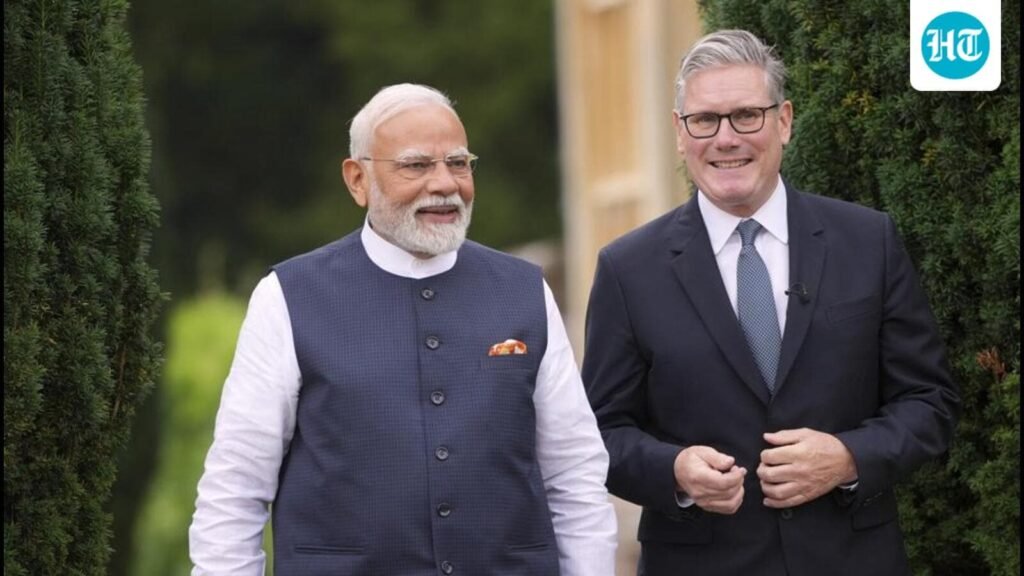
The visit of UK Prime Minister (PM) Keir Starmer to India signifies an acceleration of the bilateral relationship, moving beyond traditional cooperation towards a formalised, high-stakes alignment. This trajectory is rooted in the India-UK Vision 2035, a document that sets ambitious goals aimed at delivering “transformative opportunities and tangible benefits” for both nations, which was announced during PM Narendra Modi’s June 2025 visit to the UK.

Structured scientific collaboration between the two countries began at the 1st UK-India Science & Innovation Task Force in 2014. These initial agreements formed the basis for targeted funding mechanisms, such as the Newton. Bhabha programme, which drives foundational research. Core pillars were later established under the India-UK Technology Security Initiative (TSI) of 2024.
The operationalisation of the TSI, which is jointly monitored by the national security advisors of both countries and undergoes biannual reviews, demonstrates that technological collaboration is now inextricably linked to national security and economic resilience. This high level of scrutiny and integration ensures that cooperation in key and emerging technologies — from Artificial Intelligence (AI) to critical minerals — is prioritized for immediate, tangible early-harvest results. The cooperation extends to advanced technologies through initiatives such as the Electric Propulsion Capability Partnership (EPCP) and Jet Engine Advanced Core Technologies (JEACT). The India-UK relationship has also established a deep foundation for facilitating long-term joint R&D in areas such as semiconductors, quantum computing, biotechnology, and advanced materials.
The collaboration during the Covid-19 pandemic exemplifies our collaboration. The rapid and massive effort involving Oxford University, AstraZeneca, and the Serum Institute of India (SII) resulted in the swift production and distribution of vaccines, saving lives and critically mitigating the global spread of the virus. Now, the partnership is naturally positioned to move into cutting-edge fields such as cell and gene therapy, and genomic medicine discovery, which aligns directly with India’s new strategic thrust into biomanufacturing and biofoundry capabilities through the Biotechnology Research Innovation and Entrepreneurship Development (Bio-RIDE) scheme. Here, the Indian department of biotechnology’s long partnership with the Wellcome Trust has laid the foundations of high-quality biomedical research and is now entering its third phase.
Quantum computing, AI, and biotechnology are globally transformative technologies, and bilateral collaboration must ensure their applications serve the global public good. A prime example of this co-creation model is the research tie-up between Imperial College London and IIT Bombay. This initiative is pioneering the use of quantum computing and biotechnology to help farmers develop stronger crops that are more resilient to the challenges posed by climate change. Both nations also prioritize AI. Plans are underway to establish a joint AI center under the TSI. Future efforts must focus not only on R&D but also on the ethical and safe governance of AI. While these areas offer great opportunities and rapid growth, their unregulated expansion can pose significant security and societal risks. Here, India and the UK have the opportunity to conduct periodic, rigorous scientific reviews of developments in these areas and to influence regulatory policies and their compliance.
Future collaboration is driven by the convergence of both nations’ domestic scientific and technological priorities, ensuring that bilateral funding directly serves strategic economic objectives. India is aggressively pursuing technological advancement through a mission-mode approach. Initiatives include the launch of the National Quantum Mission, the India AI Mission, the National Green Hydrogen Mission, and the Deep Ocean Mission. The Anusandhan National Research Foundation (ANRF) has been operationalized with a mandate to enhance participation from the private sector and promote interdisciplinary research aligned with national priorities. The UK maintains similarly clear and long-term R&D priorities supported by substantial public expenditure.
The TSI explicitly defines collaboration across seven core technological pillars: AI, quantum computing, biotechnology, critical minerals, telecommunications, advanced materials, and semiconductors. By focusing on these high-stakes sectors, the partnership ensures that R&D directly contributes to mutual economic growth, security, and supply-chain resilience, as outlined in Vision 2035.
The partnership’s next phase must prioritize “science for our people” by targeting collaboration in cutting-edge fields that generate societal value and security benefits. Indian founders are increasingly regarding the UK as a strategic “proving ground”, valuing the maturity of its frameworks and the confidence it inspires in investment. This perception facilitates a critical shift, enabling Indian companies to move from merely exporting talent to launching sophisticated, compliance-ready global companies.
The UK-India strategic technological partnership must move with speed and urgency. By aligning the scientific genius of India and the UK, the two nations possess the collective capability not only to achieve shared economic goals but also to decisively address existential global challenges, opportunities and threats, delivering cleaner air, healthier populations, and resilient economies worldwide.
K VijayRaghavan is Homi Bhabha chair professor, Tata Institute of Fundamental Research, and former principal scientific advisor to the government of India. The views expressed are personal




